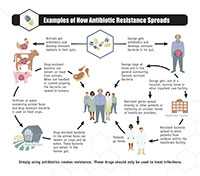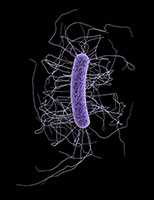Antibiotic Resistance Threats in the US
 Antibiotics are powerful tools for fighting illness and disease, but overuse of antibiotics has helped create bacteria that are outliving the drugs used to treat them.
Antibiotics are powerful tools for fighting illness and disease, but overuse of antibiotics has helped create bacteria that are outliving the drugs used to treat them.
Antibiotic resistance is a quickly growing, extremely dangerous problem. World health leaders have described antibiotic-resistant bacteria as “nightmare bacteria” that “pose a catastrophic threat” to people in every country in the world. Each year in the United States, at least 2 million people become infected with bacteria that are resistant to antibiotics, and at least 23,000 people die each year as a direct result of these infections. Many more people die from other conditions that were complicated by an antibiotic-resistant infection.
In addition, almost 250,000 people who are hospitalized or require hospitalization get Clostridium difficile each year, an infection usually related to antibiotic use. C. difficile causes deadly diarrhea and kills at least 14,000 people each year. Many C. difficile infections and drug-resistant infections can be prevented.
How Bacteria Become Resistant
 When bacteria are exposed to antibiotics, they start learning how to outsmart the drugs. This process occurs in bacteria found in humans, animals, and the environment. Resistant bacteria can multiply and spread easily and quickly, causing severe infections. They can also share genetic information with other bacteria, making the other bacteria resistant as well. Each time bacteria learn to outsmart an antibiotic, treatment options are more limited, and these infections pose a greater risk to human health.
When bacteria are exposed to antibiotics, they start learning how to outsmart the drugs. This process occurs in bacteria found in humans, animals, and the environment. Resistant bacteria can multiply and spread easily and quickly, causing severe infections. They can also share genetic information with other bacteria, making the other bacteria resistant as well. Each time bacteria learn to outsmart an antibiotic, treatment options are more limited, and these infections pose a greater risk to human health.
Infections Can Happen to Anyone, Anywhere
Anyone can become infected with antibiotic-resistant bacteria anywhere and anytime. Most infections occur in the community, like skin infections with MRSA and sexually transmitted diseases. However, most deaths related to antibiotic resistance occur from drug-resistant infections picked up in healthcare settings, such as hospitals and nursing homes.
What you can do to protect yourself against drug-resistant infections
 There are many ways you can help prevent the creation and spread of resistance. First, when you are sick, do not demand antibiotics from your doctor or take antibiotics that were not prescribed to you directly for your specific illness. When taking antibiotics, do not skip doses, and make sure to follow the directions about dose and duration from your doctor.
There are many ways you can help prevent the creation and spread of resistance. First, when you are sick, do not demand antibiotics from your doctor or take antibiotics that were not prescribed to you directly for your specific illness. When taking antibiotics, do not skip doses, and make sure to follow the directions about dose and duration from your doctor.
Second, like all diseases, common safety and hygiene methods can prevent disease and spread. Make sure to:
- Get updated and regular vaccinations against drug-resistant bacteria
- Wash your hands before eating and after using the restroom to avoid putting drug-resistant bacteria into your body
- Wash your hands after handling uncooked food to prevent ingesting drug-resistant bacteria that can live on food
- Cook meat and poultry thoroughly to kill bacteria, including potential drug-resistant bacteria
What healthcare providers can do to protect patients from drug-resistant infections
There are many ways to help provide the best care to your patients while protecting them against antibiotic-resistant infections.
- Follow all necessary infection control recommendations, including hand hygiene, standard precautions, and contact precautions.
- Diagnose and treat resistant infections quickly and efficiently. Treatment options change often because resistance is complex. Make sure to follow the latest recommendations to ensure you are prescribing appropriately.
- Only prescribe antibiotics when likely to benefit the patient, and be sure to prescribe the right dose and duration.
- Be sure to clearly label dose, duration, and indication for treatment, and include appropriate laboratory diagnostic tests when placing antibiotic orders. This will help other clinicians caring for the patient to change or stop therapy when appropriate.
- Take an antibiotic time out, reassessing therapy after 48-72 hours. Once additional information is available, including microbiology, radiographic, and clinical information, a decision can be made on whether to continue the same therapy.
- When transferring patients, ensure the other facilities are notified of any infection or known colonization.
- Keep tabs on resistance patterns in your facility and in the area around your facility.
- Finally, encourage prevention methods with your patients. Make sure they understand how to protect themselves with vaccines, treatment, and infection control practices such as hand washing and safe food handling.
More Information
- CDC Press Release: Untreatable: Report by CDC details today’s drug-resistant health threats
- Digital Press Kit: Untreatable: Today’s Drug-Resistant Health Threats
- Report: Antibiotic Resistance Threats in the United States, 2013
- CDC Antibiotic/Antimicrobial Resistance Website
- CDC Get Smart: Know When Antibiotics Work
- CDC Get Smart for Healthcare
- Page last reviewed: September 16, 2013
- Page last updated: September 16, 2013
- Content source:
- National Center for Emerging and Zoonotic Infectious Diseases
- Page maintained by: Office of the Associate Director for Communication, Digital Media Branch, Division of Public Affairs




 ShareCompartir
ShareCompartir